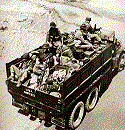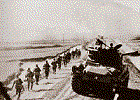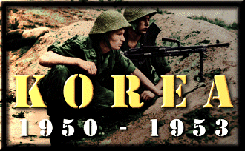The Die-Hards - Middlesex Regiment
 1st battalion vehicle,
1st battalion vehicle,James Williams
(Jimmy) as Bren gunner.
The Die-Hards commander, Colonel Andrew Man, was informed of the move of the Middlesex Regiment on Sunday 20th August 1950. The main body of the Middlesex Regiment embarked at Hong Kong on HMS Unicorn on Friday 25th August, the Commmissioner-General in South East Asia, Malcolm McDonald gave a farewell address on the flight deck. The troops were preceded by Colonel Man who left for Taegu in South Africa. The Middlesex Regiment arrived at Pusan in South Korea on 29th August with The Argyll and Sutherland Highlanders accompanying them aboard the HMS Ceylon. After an American welcome, the troops entrained and were provided with American C rations. After a mere 5 hour trip (it could have been upto 24 hours long) the Die Hards arrived at YongSang at about 11pm. They were then transported by American 2 1/2 tonne trucks to their bivouac area some six miles away. The next few days were used to finish final training, and at pretty short notice the Middlesex were ordered to take over a sector in 1st US Cavalry Area. Again, the Regiment relied on US transport to get into position, they switched positions in the US line and eventually ended up in a defensive position to the west of Taegu where the Naktong River turns south, the Argyll and Sutherland Highlanders being on their left. The only road through the sector ran parallel to the front, and frontages were very long. D Company with a 10,000 yard frontage was also blessed with a company of badly-trained and badly-led South Korean Police of some 230 men. The picture on the left shows men of the 1st Battalion, The Middlesex Regiment moving up to the Pusan perimeter.
The Middlesex suffered their first fatality when Private R. Streeter was killed returning form a patrol. He was buried the next day in the UN Military Cemetary at Taegu.
During this time, North Korean forces gained the high ground to the Middlesex positions rear, and a South Korean Police battalion was sent into clear the area with some British advisors. The North Koreans were removed.
After the Inchon Landings, a new spirit entered the Un forces and the UN charged north. After advancing through a harbour area, the Middlesex joined up with a US Recce Company and capture two high features at a village which was holding the recce company up.
The attack on Plum Pudding Hill went in the next morning, with a platoon of B company supported by two tanks. D company then moved through A Company and captured the right half of the objective, a steep hill some 900 ft high which was christened Middlesex Hill. The 1st Argyll and Sutherland Highlanders attacked the other feature on the left of the road the next morning, but as success was assured an Allied air strike hit the Highlanders with Napalm. Major Kenny Muir was awarded a posthumous VC.
Following the Inchon landings and the Un forces consolidation the Middlesex were given a vast area to clear of enemy remnants and collected in many strays over a week. Following this, the Battalion moved up to the 38th Parallel by air from Taegu to Kimpo whilst the Battalions vehicles ,which had arrived after the Middlesex Hill action, were moved by road. The air party bivouacked on Kimpo airfield and got three days rest before the vehicles reached them four days later and in under an hour the Battalion moved off, again in US transport, to take up positions 1,000 yards South of the Parallel under 1st US Cavalry Division.
The Battalion now moved north, crossing the 38th Parallel on 11th October 1950 and in the following 56 days marched , rode and clung to transport for an advance of some 700 miles. The 3rd Royal Australian Regiment had now joined the brigade, which was renamed the 27th British Commonwealth Brigade. Throughout the UN Advance, the Commonwealth brigade led the assault on the north covering a distance of approximately 160 miles after the capture of Pyongyang on the 19th October after a race between three UN divisions, the Brigade led the UN advance to within 40 miles of the Manchurian border.
The 25th October saw a new enemy on the battlefield, the Winter had arrived. Water trucks were frozen solid and soldiers who were still in tropical kit with woollen jerseys shivered in the Siberian blast. Soldiers had to learn new tactics for survival.
Then the Chinese intervened, on 5th November 27 Brigade made a perilous retreat to the Chongchon river, in which the Vickers machine gun once again proved its ability to stop massed attackers. With the Argylls and Australians preventing the Chinese from cutting the Brigades supply lines. This was followed by a violent and frightening assault by frost, causing a host of problems which were eased by the issue of American windproof jackets and fur caps. By 16th November, the Middlesex was at Pakchon in defensive positions with the US 4th Division to the north-west, the Argylls north and Australians to the North-West.
At this stage, information on Chinese numbers was inaccurate varying between hundred of thousands and two million Chinese troops. Under heavy Chinese attacks, the Battalion was ordered to withdraw to Chasan. The Battalions vehicles were overloaded with American wounded, although a great many dead had to be left behind for lack of transport.

In Pyongyang, the battered 27th Brigade met up with the fresh and well-equipped 29th brigade newly arrived from the Uk. The 27th brigade also received an American 4.2-inch mortar battalion for support. The Battalion rested north of Seoul until New Year's Day, when the Chinese attacked, the main thrust falling upon the US 24th and 2nd ROKS Division. The Commonwealth Brigade covered the retreat as the population of Seoul fled south. The Chinese broke through the UN lines on 3rd January, and the retreat continued to new lines at Uijongbu. On 18th January, the brigade took up positions on some very rugged 1,500ft hills with deserted but well prepared defences. After the Chinese advance was halted, the Brigade, now joined by Canadians, moved eastwards to pinch out a Chinese salient in the UN lines. The Brigade was relived a few days later and sent back for some much-needed rest. During this time, Colonel Man relinquished command on the grounds of ill-health. The picture on the right shows men of the Die Hards passing some US M4A3s Tanks.
The Brigade now came under 24 Division and was ordered to move forward into the front lines as the Chinese began withdrawing in mid-March. Backed up by masses of friendly South Korean porters to help pull the infantry's stores, the UN armies began to advance again.
On 28th March, The Battalion sent two companies along high ground and then leap-frogging the reserve companies through a valley. By the afternoon, the battalion was in place and the Australians passed through the next morning. The Australians got some reception form a Chinese rearguard and C company was sent to assist, and on 30th March 'C' Company advanced under intermittent fire, which was later silenced by UN artillery. The Brigade decided to finish the mission with a wide flanking movement with the Middlesex capturing the vital ground, point 1036. This envolved in an approach march on foot of 6 miles over the most formidable country.
31st march, saw the attack proper begin. D Company reached a ridge at right angles to the objective some 800 yards distant by mid-afternoon. The Objective was held in force by the Chinese and D Company was withdrawn as light faded. The "Oak" was captured the next day after a combined artillery and air strike, followed up by a D Company platoon. The Brigade now sidestepped and cleared out a second valley, the 1st middlesex having gained all its objectives without opposition by mid-afternoon on 3rd April.
After a four-day wait, the brigade moved in to clear out the valley proper which was accomplished on April 15th. 27th brigade now moved into Corps reserve again, but unfortunately the 6 ROK Division which had taken over from the 27th, withdrew leaving the hard-won valleys to the Chinese again on 23rd April. The Chinese were advancing again and the brigade withdrew into Corps reserve after some rearguard actions in the area of Yangyong on April 26th.
Up until their withdrawal from Inchon on 14th May, after being relieved by 28th Battalion from Hong Kong the 1st Middlesex were on the alert for the possible need to spearhead a Brigade advance. The Battlions last gift to the Korean war was some excellently laid wire which held up the Chinese in the advance three weeks after they had left and allowed the Australians to kill hundreds of Chinese who got caught up in the wire.
The 1st Middlesex Battalion was awarded seven battle honours in recognition of its service in Korea, These were:
- Korea 1950-51*
- Naktong Bridgehed*
- Chonju
- Chongchon
- Chuam-ni
- Kapyong-chon
- Kayong
*=These two were carried on the former Regimental Colours.



